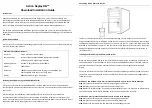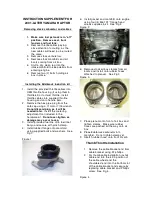
FT500 SFI / FT500LITE SFI
53
Sensors and Calibration
15.17 EGT
This menu allows to setup the EGT conditioners (ETM-1 or EGT-8 CAN)
e perform the cylinder atributtion. To do it, simply select the cylinder
where the EGT is placed and what is the conditioner.
The atributtion can be done using the CAN network with EGT-8 CAN
or using the white wires inputs with ETM-1.
EGT
General
Left bank
Right bank
Cylinder 1
Cylinder 5
Cylinder 9
Cylinder 2
Cylinder 6
Cylinder 10
Cylinder 3
Cylinder 7
Cylinder 11
Cylinder 4
Cylinder 8
Cylinder 12
Cylinder 4 1/3
White 5: Avaliable
Input selection
CAN 2.0
White 7: Avaliable
White 8: Avaliable
White 6: Avaliable
Cylinder 4 2/3
Channel association
Equipment
Channel
EGT A
EGT B
1
Cylinder 4 1/3
None
Input selection
White 4: Avaliable
white 2: Pitch rate
White 3: Davis profiler input
White 1: Avaliable
Cylinder 4 2/3
Select the sensor type
ETM-1
Custom
Cylinder 4 3/3
Input value
Output value
Sensor offset
+10,7
56,0
°C
°C
Reading
16. Starting the engine for the first time
This chapter shows final steps before the engine first start and guides
the user through checking and calibrating all the sensors and actuators
of the motor.
16.1 First engine start
Try not to push the starter motor and the coils by cranking the starter
too long on the first start. Check if the fuel pump is turned on and if
there is fuel pressure on the line. Check if the FT500 / FT500LITE
reads the correct RPM in its dashboard and make sure there’s spark
on the spark plugs (unplug the spark plug wires and install a spark
plug on it to check for spark).
On engines fueled with ethanol or methanol, use gasoline on the
throttle body to make the first start smooth.
When the engine starts, keep it at a fast idle and double check oil
pressure and the coil and igniter temperature.
Check if the RPM is being correctly shown on the ECU display (if
possible, compare to an external tachometer) and if throttle variations
coincide with TPS and vacuum readings.
16.2 Ignition calibration
Once the engine has started, before any kind of test or tune, the ignition
calibration must be performed. This calibration is very important to
make sure the timing the ECU reads is really correct with the engine.
The access to this function is given by the “Ignition” button in the
main FTManager menu or the “Calibrate ignition” in the touchscreen
“Sensors and Calibration” menu
Ignition calibration
100,1
°
25
dentes
+3,2º
Adjust calibration
until match 20° at
timing light
(Some timing light
may read 40°)
Locked ignition
0°
20°
Ignition calibration
100,1
°
25
Teeth
+3,2º
Adjust calibration
until match 0° at
timing light
Locked ignition:
0°
20°
This function locks the timing to 20° (or 0°) on any RPM, this means,
if the engine starts but has no idle, you can rev it up and keep it in
something around 2000rpm to perform the calibration. Avoid RPM
variations as this causes variations on the timing light readings.
















































